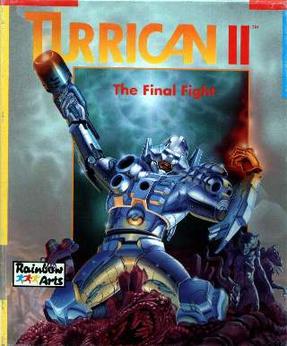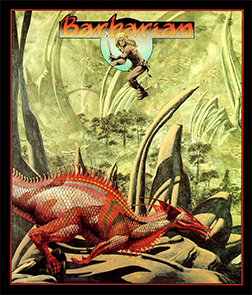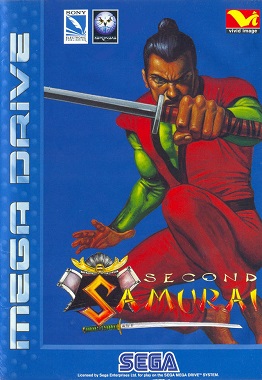
In computer graphics, a sprite is a two-dimensional bitmap that is integrated into a larger scene, most often in a 2D video game. Originally, the term sprite referred to fixed-sized objects composited together, by hardware, with a background. Use of the term has since become more general.

Shoot-'Em-Up Construction Kit is a game creation system for the Commodore 64, Amiga and Atari ST created by Sensible Software and published by Outlaw in 1987. It allows the user to make simple shoot 'em ups by drawing sprites and backgrounds and editing attack patterns. The advertising promoted the Kit with the phrase "By the programmers of Wizball and Parallax".

Xenon 2: Megablast is a 1989 shoot 'em up video game developed by The Bitmap Brothers and published by Image Works for the Amiga and Atari ST. It was later converted to the Master System, PC-98, X68000, Mega Drive, Commodore CDTV, Game Boy, Acorn Archimedes and Atari Jaguar platforms. The game is a sequel to Xenon and takes place a millennium after the previous title. The goal of the game is to destroy a series of bombs planted throughout history by the Xenites, the vengeful antagonists of the first game.

Turrican II: The Final Fight is the second game of the Turrican series. The game, developed by Factor 5 was released in 1991 for the Commodore Amiga. This version was finished before the C64 version, but Manfred Trenz cites the C64 version as the original design. Turrican II was also released for the CDTV, Atari ST, Amstrad CPC and ZX Spectrum, and later for DOS, and also for the Mega Drive/Genesis and Game Boy rebranded as Universal Soldier.

Wrath of the Demon is a 1991 hack and slash video game developed by Quebec-based developer Abstrax, and published by ReadySoft. Versions for Atari ST, Amiga, Commodore CDTV, and MS-DOS were released in early 1991. A Commodore 64 version was released later.

Exolon is a run and gun game programmed by Raffaele Cecco and published by Hewson in 1987 for the ZX Spectrum, Commodore 64, and Amstrad CPC. It was later converted to the Enterprise 128, Amiga, and Atari ST.

CarVup is a platform game developed and published by Core Design in 1990. Based on Jaleco's 1985 arcade game City Connection, it was released for the Amiga and Atari ST.

Barbarian is a 1987 platform game by Psygnosis. It was first developed for the Atari ST, and was ported to the Amiga, Commodore 64, MS-DOS, MSX, Amstrad CPC, and ZX Spectrum. The Amiga port was released in 1987; the others were released in 1988. The cover artwork is by fantasy artist Roger Dean.
Raffaele Cecco is a British video games developer who has created numerous video games since 1984, including Cybernoid and Exolon. He grew up in Tottenham in North London. Spurred by an interest in computers, he received his first computer, a Sinclair ZX81, as a birthday gift from his parents in 1981 and began programming simple games in BASIC.

Gauntlet III: The Final Quest is a home computer game by U.S. Gold and Tengen it was released in 1991 for the Amiga, Atari ST, Commodore 64, ZX Spectrum, and Amstrad CPC. Besides the standard four main Gauntlet characters, Thor, Thyra, Merlin, and Questor, four new playable characters were available: Petras, a rock man; Dracolis, a lizard man; Blizzard, an ice man; and Neptune, a Merman. The game is viewed from an isometric perspective and the cooperative multiplayer mode supports two-players.

Hammerfist is a side-scrolling beat 'em up video game developed by Vivid Image and released in 1990 for the Amiga, Atari ST, Commodore 64, Amstrad CPC and ZX Spectrum.

Last Ninja 3 is an action-adventure video game that was developed and published by System 3 for the Commodore 64, Amiga, Atari ST in 1991. It is a sequel to the 1988 game Last Ninja 2.

Second Samurai is a video game released for the Amiga in 1993. It is the sequel to the 1991 game First Samurai. A Mega Drive version was later released in 1994 which features different graphics, sound and level design to the Amiga version.

Predator 2 is a 1990 rail shooter video game developed by Oxford Mobius and Arc Developments and published by Image Works, Konami and Mirrorsoft for MS-DOS, Amiga, Amstrad CPC, Atari ST, Commodore 64, and the ZX Spectrum. It is based on the film of the same title.

The Real Ghostbusters is a 1987 shoot 'em up arcade game developed and published by Data East. It is loosely based on Ghostbusters. In Japan, Data East released it as a non-Ghostbusters arcade game under the title Meikyuu Hunter G. In 1989, Activision published The Real Ghostbusters for Amiga, Amstrad CPC, Atari ST, Commodore 64, and ZX Spectrum.

Ninja is a beat 'em up game developed by Sculptured Software and released by Mastertronic in 1986 for the Atari 8-bit computers, Commodore 64, and ZX Spectrum, then in 1987 for the Amstrad CPC, Amiga, Atari ST, and MS-DOS. An arcade version of the game was released in 1987 for Mastertronic's Arcadia Systems which is based on Amiga hardware. The Amiga, Atari ST, and Arcade versions were released as Ninja Mission. As a Ninja, the player attacks a fortress made of individual fixed screens which can be explored non-linearly.

Terminator 2: Judgment Day is a 1991 action video game developed by Dementia and published by Ocean Software. It is based on the 1991 film of the same name, and was released in Europe for Amiga, Amstrad CPC, Atari ST, Commodore 64, DOS, and ZX Spectrum. It is a sequel to The Terminator, itself based on the 1984 film of the same name. The game features several gameplay styles such as driving, fighting, and puzzle-solving.

Judge Dredd is a 1991 platform shoot 'em up video game based on the character of the same name. It was developed by Random Access and published by Virgin Mastertronic. It was released in Europe in 1991, for the Amiga, Atari ST, Commodore 64, and ZX Spectrum. Critics found the gameplay repetitive.

Deathbringer is a 1991 side scrolling action game developed by Oxford Digital Enterprises and published by Empire that was released for the Amiga, DOS, and Atari ST.

Mevlüt Dinç, better known as Mev Dinc, is a Turkish-British video game designer. Born and raised in Turkey, he moved to England in 1979 while finishing his studies, intending to pursue a master's degree there. Unable to pay the high tuition fees for international students, Dinc worked in a cable factory in Southampton, where a colleague introduced him to video games and got him a ZX Spectrum when it was released in 1982. Dinc taught himself to program via magazines and began working in the video game industry in 1983, starting with assisting on the Commodore 64 conversion of Ant Attack, released in 1984. After his first original game, Gerry the Germ Goes Body Poppin', in 1985, he worked with Electric Dreams Software on another original game, Prodigy, the Amstrad CPC port of Enduro Racer, and various tie-ins with films and TV series.



















